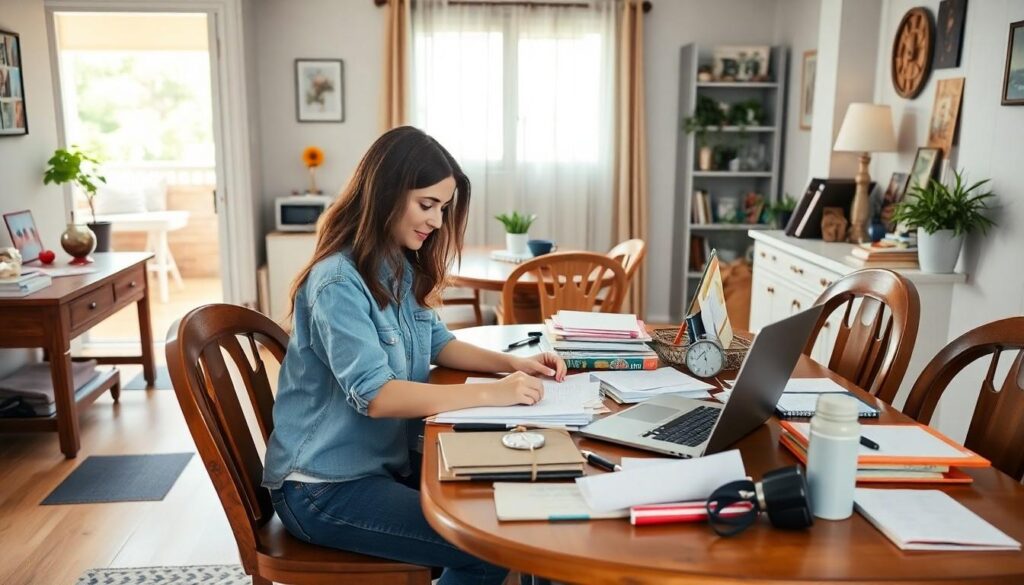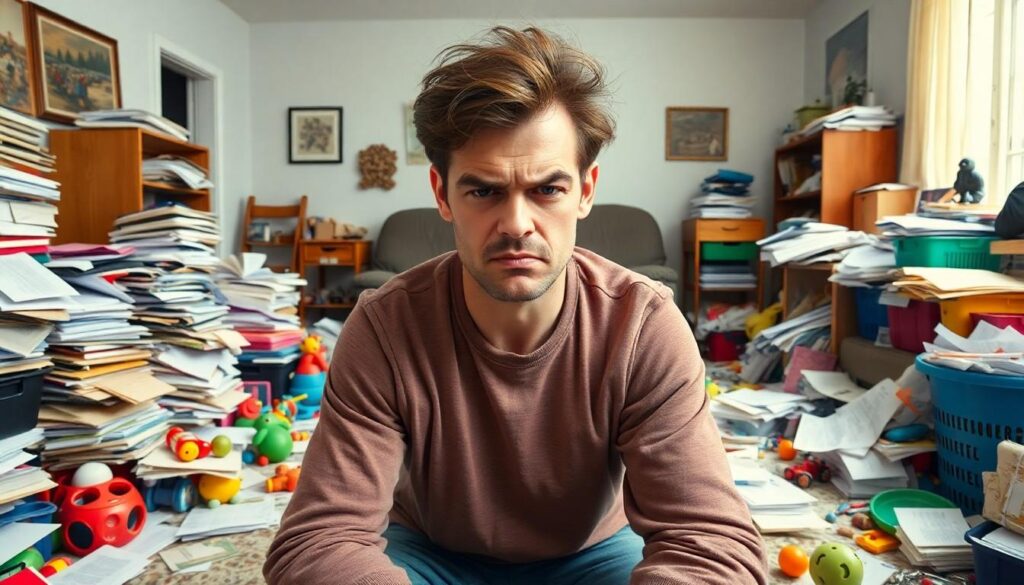Feeling overwhelmed by clutter but never seem to find enough time to tackle it?
Decluttering isn’t just about creating a prettier space, but it’s essential for your overall wellbeing, yet it can feel impossible when you’re already juggling a busy schedule.
You’re not alone.
The good news?
With strategic approaches like the One Method (removing just one item on extremely busy days) or the 2-for-1 rule (removing two items for every new purchase), you’ll build consistent habits with minimal daily investment. Even five minutes can make a difference when you have the right system in place.
You don’t need massive blocks of time to transform your home.
Why it’s so darn hard to keep our homes organized these days
Maintaining an organized home has become increasingly challenging in our modern lifestyle. The constant juggling of responsibilities creates the perfect storm for clutter to accumulate rapidly in our living spaces.
We’re obsessed with being busy (and it’s hurting our homes)
Being “busy” has transformed from a temporary state into a permanent lifestyle for most Americans. Research shows that 8 out of 10 people respond with “busy” when asked how they are.
This constant state of activity doesn’t just affect our mental health; it’s taking a serious toll on our living spaces too.
The American ‘busyness’ status symbol
Busyness has evolved into a strange status symbol in American culture. Being overwhelmed with tasks and commitments is often viewed as a badge of honor, signaling importance and productivity.
When you’re constantly rushing from one commitment to another, home organization inevitably falls to the bottom of your priority list.
This cultural shift has created an environment where high effort is considered morally admirable regardless of the actual output or toll it takes.
Why clutter builds up when we’re always on the go
Clutter accumulates exponentially when you’re living life at full speed. When you’re constantly rushing, there’s no time to put things back in their proper places.
The psychological weight of seeing this chaos each day adds to your stress levels, making you feel even more overwhelmed and less likely to tackle the problem.
Each busy day adds another layer to the mess, creating a vicious cycle where the growing disorganization makes daily tasks even more time-consuming.
Mail piles up on countertops, laundry stays unfolded, and shopping bags remain unpacked.
Hybrid work has completely changed how we use our homes

Our homes now function as dual-purpose spaces, serving as both living quarters and workplaces. Hybrid work models have transformed domestic environments, requiring us to rethink organization and space utilization in entirely new ways.
The challenge of creating dual-function spaces
Creating spaces that seamlessly transition between professional and personal use presents unique organizational challenges. Living rooms double as conference rooms, kitchens become break rooms, and bedrooms transform into offices.
This dual functionality demands systems that balance professional organization with personal comfort.
The constant switching between work mode and home mode creates boundary blurring that affects both our productivity and relaxation. Your dining table covered in work documents makes it hard to enjoy family meals.
Meanwhile, personal items creeping into work spaces can disrupt focus during important calls. Creating distinct zones with flexible, multi-functional furniture helps maintain these necessary boundaries while accommodating both purposes.
Why your home office is probably a mess (and what to do about it)
Home offices often become clutter magnets because they lack the structured organization systems found in traditional workplaces. Without dedicated storage solutions or clear boundaries, work materials spread throughout your living space.
The solution starts with establishing physical boundaries; even a folding screen can create psychological separation between work and living areas. Install vertical storage to maximize limited space, using wall-mounted shelves and hanging organizers.
Create a “daily reset” ritual where you pack away work items at day’s end, signaling to your brain that work time is over. This practice reduces stress and creates mental space needed for effective decluttering, helping you avoid the trap of continuous busyness that leaves no room for organization.
The real cost of clutter: stress, anxiety, and lost productivity

Clutter isn’t just an eyesore; it’s actively draining your mental energy and stealing your time. Research indicates cluttered spaces create stress and anxiety, make finding items difficult, and reduce focus and productivity.
How clutter affects your mental health
A messy environment directly impacts your psychological wellbeing. Research shows that disorganized spaces increase cortisol levels, which is your body’s primary stress hormone, creating constant low-level anxiety.
This mental burden creates a vicious cycle: the more stressed you feel, the harder it becomes to tackle the clutter causing that stress.
When surrounded by visual chaos, your brain works overtime to process all the stimuli, leading to cognitive overload and mental fatigue. The psychological toll includes feeling overwhelmed, embarrassed about your space, and experiencing difficulty relaxing in your own home.
The hidden productivity tax you’re paying
Disorganization silently steals your time and efficiency every day.
Your cluttered environment ultimately hampers creativity and problem-solving by occupying mental bandwidth that could be used for more productive thinking.
Decision fatigue sets in when faced with too many objects competing for attention, making it harder to prioritize tasks effectively.
This daily “clutter tax” adds up to hours of lost productivity each week. A disorganized environment also reduces your ability to focus on important tasks, as your attention constantly shifts to surrounding visual distractions.
When your space is cluttered, you waste precious minutes searching for misplaced items, such as keys, documents, or supplies.
Decluttering philosophies from around the world (and what actually works)

Different cultures have developed unique approaches to organizing living spaces, each with valuable insights for tackling your clutter challenges. These philosophies offer varied perspectives on our relationship with possessions and the spaces we inhabit.
Traditional Western approaches: practical but sometimes soulless
Western decluttering methods focus on efficiency and practicality with clear step-by-step systems. They’re methodical and results-oriented but sometimes miss the deeper emotional connections we have with our stuff.
The classic ‘three-pile’ sorting method
The hallmark of Western organization is the three-category system: keep, donate/sell, and discard.
While simple to understand, this method doesn’t address why you’re attached to things in the first place.
This straightforward approach makes quick decisions possible; you touch an item once and immediately determine its fate.
Why the ‘reduce, arrange, maintain’ philosophy makes sense
This Western approach takes organization a step further: remove everything from a space, group similar items together, then reassess their usefulness. The strength of this method is in its logical grouping systems and emphasis on maintenance through habits and clear labeling.
It’s particularly effective for spaces like kitchens and offices where function trumps sentiment.
Where Western approaches fall short
Traditional Western methods often prioritize external organization over emotional connections. They’re great for creating visually appealing spaces but might not address why you accumulated clutter initially.
The focus on contained spaces (drawers, cabinets) rather than whole rooms can sometimes lead to “out of sight, out of mind” solutions that don’t truly resolve your relationship with possessions.
Eastern methods: bringing mindfulness to the mess
Eastern philosophies offer a unique approach to decluttering that connects physical order with mental wellbeing. These methods go beyond simply organizing stuff and address the deeper relationship between your space and your mind.
The KonMari magic: more than just folding techniques
The KonMari method breaks traditional organizational rules by focusing on categories rather than locations.
By holding each item and reflecting on your connection to it, you’re not just organizing; you’re clarifying what truly matters in your life and creating space for more joy.
The heart of this approach is the simple yet profound question: “Does this item spark joy?” This emotional evaluation transforms decluttering from a chore into a mindful practice.
Instead of tackling your bedroom or kitchen, you’ll sort through all your clothing at once, then books, papers, and so on.
Feng Shui: it’s all about the energy flow
Feng Shui centers on the concept of chi, the energy that flows through your home. Clutter blocks this energy, creating stagnation in both your space and life.
Removing broken items is particularly important in Feng Shui practice, as they’re believed to hold negative energy. A decluttered home following these principles does not just look better; it feels better too, creating harmony between your physical environment and emotional state.
The entryway, known as the “mouth of chi,” is your starting point for decluttering since it’s where energy first enters your home. Clear pathways throughout your living space allow positive energy to circulate freely.
The Re: Method: Eastern wisdom meets Western efficiency
The Re: Method blends KonMari’s mindfulness with practical Western efficiency.
Unlike strictly Western methods that focus solely on utility or Eastern approaches that might seem too philosophical, the Re: Method meets you where you are. It tailors organization around your specific needs rather than forcing a one-size-fits-all solution, making decluttering feel less like a rigid system and more like a personalized journey toward an intentionally designed home.
This hybrid approach starts with observation, taking time to understand how you actually use your space before removing anything. It incorporates the emotional connection aspect of KonMari while adding waste-reduction techniques.
Going minimal: less stuff, more life
Minimalism isn’t just about empty rooms and white walls; it’s about creating space for what truly matters. By reducing excess possessions, you’re actually making room for experiences, relationships, and mental clarity that bring genuine satisfaction.
The ‘one thing a day’ technique anyone can do
The One Method makes decluttering manageable even with the busiest schedule.
The beauty lies in its simplicity; there’s no need for marathon cleaning sessions when consistent small steps create significant change over time.
On particularly hectic days, just removing that single item keeps your decluttering habit alive.
Simply remove one item from your home each day, such as a broken pen, an outdated magazine, or clothes you haven’t worn in years. This approach builds momentum without overwhelming you.
Smart rules to prevent future clutter
Create personal decluttering guidelines that match your lifestyle. The 2-for-1 rule works wonders: for every new item you bring home, remove two existing ones.
These simple boundaries make decision-making automatic and help maintain your progress without constant mental debate about what stays and what goes.
This not only prevents accumulation but gradually reduces what you already have. Another effective approach is: if you haven’t touched something in the past 12 months, it probably doesn’t deserve your space.
Clever storage solutions that don’t break the bank
Maximize vertical space with wall-mounted shelves or hooks in entryways, kitchens, and bathrooms.
Remember that the best storage isn’t about hiding more stuff but highlighting the items you truly value and use regularly.
Multi-purpose furniture like storage ottomans or beds with drawers underneath creates hidden organization zones without taking extra floor space. The key is thinking beyond traditional storage and looking for opportunities to store items where you actually use them.
Repurpose unexpected items like vintage crates or ladder shelves that add character while organizing your essentials.
Swedish Death Cleaning: morbid name, brilliant concept
Swedish Death Cleaning (döstädning) is a thoughtful decluttering approach that focuses on simplifying your life to reduce the burden on loved ones after you’re gone. Despite its somewhat morbid name, this Swedish tradition offers a practical, compassionate way to think about your possessions.
It’s not just for the elderly (despite the name)
Don’t let the name fool you; Swedish Death Cleaning isn’t exclusively for seniors planning their final years.
Starting earlier gives you more time to thoughtfully process your belongings and make deliberate choices about what stays in your life.
Anyone can benefit from this mindful approach to possessions, whether you’re 30 or 80.
This cultural tradition from Sweden works beautifully for people of all ages who want to live more intentionally.
The brilliant ‘burden’ question to ask about your stuff
The genius of Swedish Death Cleaning lies in one simple question: “Will anyone be happier if I keep this?” Consider whether your items would become a burden to those left behind.
This perspective shift transforms decluttering from a self-focused activity into an act of love. It’s about lightening the emotional and physical load others might someday face when dealing with your possessions.
Would your loved ones appreciate inheriting that collection of old magazines or dozens of mismatched coffee mugs?
Why this slow-and-steady approach might be perfect for you
Swedish Death Cleaning intentionally moves at a gentle pace.
The unhurried nature of döstädning creates space for reflection while still making consistent progress.
It’s perfect if you’ve been overwhelmed by more intensive decluttering methods that demand quick decisions.
The process typically begins with larger items like furniture before gradually working down to clothing and smaller belongings. This methodical approach acknowledges that meaningful decluttering takes time, sometimes months or even years, allowing you to process emotional attachments without feeling rushed.
Feng Shui decluttering: clearing energy blocks in your home
Feng Shui decluttering focuses on improving energy flow throughout your living space. Clutter blocks positive energy (Chi) and creates negative energy that affects your wellbeing.
Why your entryway matters more than you think
Your entryway serves as the “mouth of Chi” – the primary pathway for positive energy to enter your home. When this area is cluttered with shoes, coats, mail, and bags, you’re literally blocking good energy from flowing into your living space.
Clear pathways from your front door allow Chi to circulate freely throughout your home, bringing vitality and positive energy. Start your decluttering journey here for maximum impact – a tidy entryway not only creates a welcoming first impression but sets the energetic tone for your entire home.
The connection between cleanliness and energy
Cleanliness goes beyond appearance in Feng Shui – it directly impacts energy quality.
Even simple acts like making your bed each morning create order that supports positive energy movement. When your space is clean, you’ll notice an immediate shift in how it feels – lighter, brighter, and more inviting.
Wipe down surfaces, vacuum floors, and clean windows to allow light and energy to flow freely.
Dust, dirt, and grime collect and hold stagnant energy, preventing fresh Chi from circulating. Regular cleaning isn’t just about tidiness; it’s about maintaining energetic harmony.
Broken items: why they’re energy vampires
Broken items drain positive energy from your home like tiny energy vampires. That cracked mirror, chipped mug, or lamp that doesn’t work aren’t just eyesores – they’re constantly leaking negative energy.
Repairing things promptly maintains healthy energy flow, but if something can’t be fixed, it’s time to let it go. Releasing these broken items creates space for new, positive energy to enter your home and life.
In Feng Shui, these damaged objects symbolize stagnation and broken opportunities. They subconsciously remind you of what’s not working in your life.
The ultimate decluttering approach for busy Americans
The hybrid decluttering model combines the best elements from global organizational philosophies to create a flexible system that works even when time is scarce. This approach integrates Western efficiency, Eastern mindfulness, minimalist principles, and Swedish Death Cleaning in a practical way that accommodates the American obsession with busyness.
8 principles that actually work when you’re short on time
These eight principles form a customizable framework that integrates multiple decluttering philosophies. They’re designed for the approximately 80% of Americans who default to “busy” when asked about their state, offering flexible solutions that don’t require massive time investments.
Start small and build momentum
Begin with tiny, five-minute decluttering sessions focused on high-impact areas like entryways or countertops. Use the One Method on your busiest days: just remove a single item.
This builds psychological momentum without overwhelming you and gradually transforms your space over time.
Mix location-based and category-based organization
Alternate between tackling specific spaces (like drawers) and sorting by categories (like clothing). This hybrid approach prevents burnout and keeps the process fresh.
Start with small, contained areas for quick wins before moving to whole-room reorganization.
Pay attention to energy flow (seriously)
Consider how energy moves through your home.
Feng Shui principles highlight the importance of your entryway as the “mouth of Chi” where energy enters. Remove obstacles in pathways and prioritize fixing or removing broken items that function as “energy vampires” draining your space’s positive atmosphere.
Use the dual-criteria decision method
Combine the practicality of Western decluttering’s “unused for a year” rule with the KonMari method’s emotional “spark joy” question. This dual approach addresses both logical and emotional attachments to possessions, making decisions clearer and faster.
Create storage systems that match your actual life
Design organization solutions around your real habits, not idealized ones. If you always drop mail on the kitchen counter, create a processing station there instead of fighting your natural patterns.
This practical approach ensures your systems remain sustainable.
Develop habits that prevent future clutter
Implement rules like the minimalist 2-for-1 guideline: remove two items for every new one you bring home. Create a “decide later” box with a firm review date to prevent decision fatigue without accumulating more clutter during busy periods.
Set up distinct zones for hybrid work
Designate specific areas for work materials in hybrid work environments.
Use visual cues to separate professional and personal spaces, even in multipurpose rooms. This zoning prevents work clutter from spreading throughout your home and preserves mental boundaries.
Build maintenance routines that fit your schedule
Integrate brief, daily reset sessions (even just 5 minutes) before bed to prevent clutter buildup.
Consistency in small doses beats occasional marathon sessions.
Create different maintenance plans for different energy levels: light straightening for busy days, deeper organization for more spacious times.
How to actually implement this stuff when you’re crazy busy
Time constraints don’t have to stop your decluttering progress. With strategic approaches and smart tricks, you can make meaningful improvements even during your busiest seasons.
The 15-minute high-impact decluttering method
The quick walkthrough technique identifies problem areas without overwhelming you. Grab a notebook and spend 15 minutes moving through your home, jotting down spaces that need attention most.
This targeted approach means you’re tackling high-impact spots first, creating noticeable improvements that motivate further progress. Don’t try fixing everything; concentrate on what’s causing the most stress or wasting the most time in your daily routine.
Focus on areas causing daily frustration or visibly cluttered zones.
The ‘decide later’ box trick
Decision fatigue often stops decluttering momentum. The three-category sorting system (keep, donate/sell, discard) works well, but adding a fourth “decide later” box transforms the process.
Set a deadline to revisit this box, perhaps in two weeks, when you’re fresh and can make clearer decisions. This prevents the perfectionism trap while keeping your decluttering sessions moving forward at a steady pace.
This temporary holding zone prevents you from getting stuck on emotionally charged or complicated items.
Micro-decluttering moments that add up
On particularly hectic days, the One Method keeps your decluttering habit alive without demanding significant time. Simply remove one item: a broken pen, an outdated magazine, or clothes you no longer wear.
Even clearing one small drawer or shelf weekly leads to substantial results over months.
These micro-moments create surprising progress over time and maintain your decluttering momentum. Try five-minute bursts while waiting for coffee to brew or during commercial breaks.
Smart storage solutions for hybrid work
Create designated storage spaces for work materials to maintain clear boundaries in dual-purpose areas.
This physical separation helps maintain both organization and work-life balance.
Consider vertical storage options like floating shelves that maximize space without consuming valuable floor real estate. Implement a daily reset routine where you pack away work items at day’s end, signaling a shift from professional to personal time.
Portable containers let you easily transition spaces from professional to personal use and back again.
The surprising mental health benefits of getting organized
Organized spaces significantly impact psychological wellbeing beyond just creating character. Research shows organized environments reduce stress and anxiety while improving focus and productivity.
Why cleaning your desk might be better than meditation
Decluttering your desk delivers immediate mental relief comparable to meditation practices. When you organize your workspace, your brain experiences reduced cognitive overload, allowing it to process information more efficiently.
This simple act of organization provides a quick mental reset without requiring the time commitment of formal meditation sessions.
Studies indicate that people working in tidy environments can concentrate for 7-8 minutes longer than those in cluttered spaces.
How physical order creates mental clarity
Physical organization directly translates to mental organization through environmental psychology principles. A tidy space reduces visual distractions that fragment your attention and deplete cognitive resources.
When your surroundings are orderly, your brain doesn’t waste energy processing unnecessary visual stimuli, freeing up mental bandwidth for creative thinking and problem-solving. This connection works both ways; organizing your physical environment creates environments conducive to both productive work and genuine relaxation.
Progress over perfection: the key to lasting change
Sustainable organization emerges from consistent small actions rather than perfectionistic overhauls. Embracing gradual improvement through micro-decluttering sessions (like five minutes each evening) builds momentum without overwhelming you.
This approach acknowledges organization as an evolving habit rather than a one-time project, making it accessible even during busy periods. The psychological benefit comes from celebrating incremental wins instead of feeling defeated by unrealistic standards, creating positive reinforcement that sustains long-term organizational habits.
Finding your personal decluttering style
Decluttering isn’t one-size-fits-all. Whether you prefer the methodical approach of Swedish Death Cleaning or the energy-focused principles of Feng Shui the key is finding what resonates with your lifestyle and schedule.
Remember that progress happens in small steps. Those five-minute decluttering sessions and one-item-a-day habits can transform your space over time without overwhelming you.
Your home should support your wellbeing not drain it.
As you implement these strategies you’ll likely discover benefits beyond just a tidy space – reduced stress improved focus and a home that truly feels like a sanctuary. The journey to an organized home isn’t about perfection but about creating space for what matters most to you.

